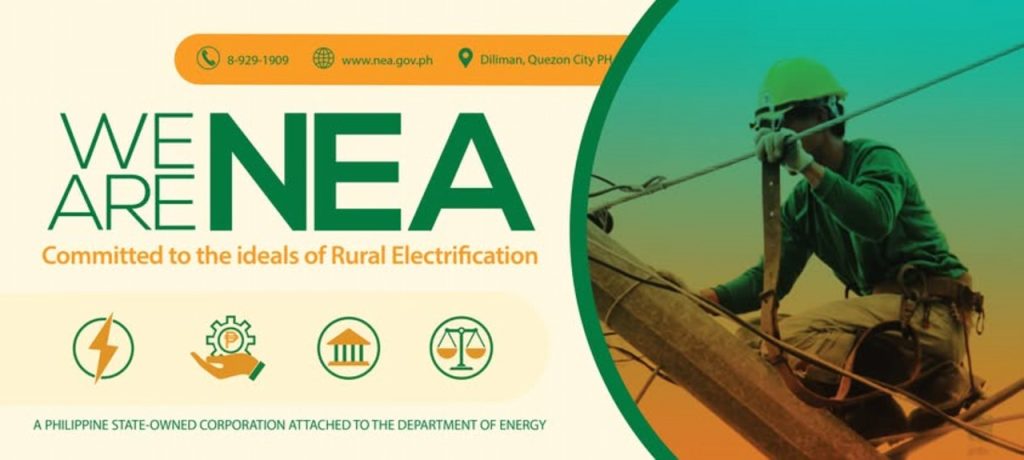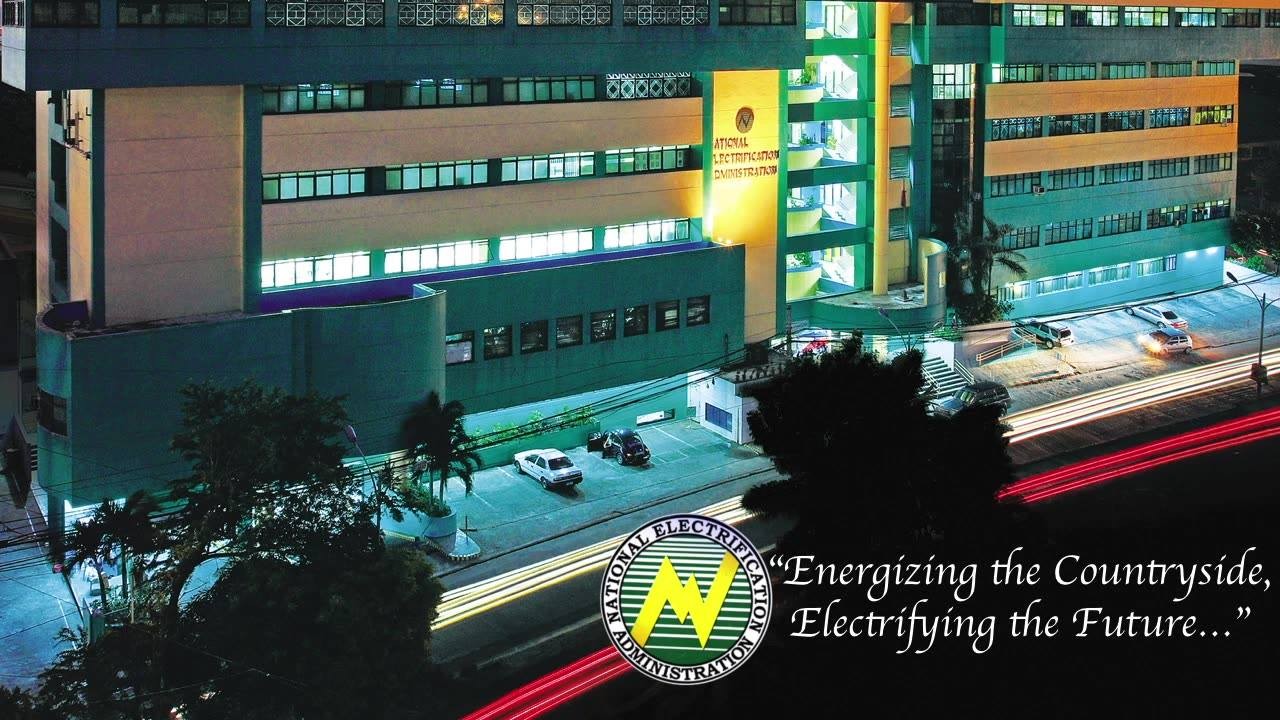The National Electrification Administration (NEA) is a government-owned and controlled corporation (GOCC) under the Department of Energy (DOE) tasked with expanding energy access through the Philippine Rural Electrification Program. Since its creation in 1969, NEA has provided financial, institutional, legal, and technical support to electric cooperatives (ECs), helping deliver electricity to rural areas and off-grid communities across the country.
With the long-term goal of achieving full electrification by 2028, NEA continues to adapt its services, policies, and lending programs to respond to changes in the Philippine electric power industry.
Overview

NEA focuses exclusively on supporting rural electrification through ECs rather than directly distributing power. Unlike other energy-related GOCCs, NEA holds both developmental and regulatory functions—offering financial assistance, institutional support, and performance monitoring of ECs. It acts as both a lender and an oversight body, maintaining accountability while fostering the growth and operational capability of ECs in underserved areas.
NEA vs NAPOCOR
NEA focuses on rural electrification by supervising and supporting Electric Cooperatives (ECs), while the National Power Corporation (NAPOCOR) is primarily tasked with power generation and transmission, especially in missionary and off-grid areas. NEA also operates as a financing, regulatory, and capacity-building body for ECs, whereas NAPOCOR manages government-owned power plants and maintains transmission lines in areas not covered by the private sector. Note that NEA does not generate or directly distribute electricity, unlike NAPOCOR, which supplies power in isolated communities through its Small Power Utilities Group (SPUG). Both are GOCCs under the energy sector, but their mandates and operational scopes serve different parts of the country’s electrification efforts.
History and Legal Bases
NEA was formally established on August 4, 1969, through Republic Act No. 6038 to address the widespread lack of electricity access in rural areas across the Philippines. It was created as a response to the limitations of private utilities that concentrated services in urban zones, leaving most of the countryside without power. In 1973, NEA was restructured into a government-owned and controlled corporation via Presidential Decree No. 269, granting it expanded powers such as loan provision, rate-setting, and franchise regulation. Presidential Decree No. 1645 in 1979 further increased its authority and capitalization, while Republic Act No. 10531 in 2013 reinforced NEA’s role in helping ECs become financially viable under a deregulated energy sector. These legal milestones shaped NEA’s mandate to support rural electrification through financial, technical, and institutional assistance to ECs nationwide.
Vision (2028)
Its vision is to:
“Promote good governance, competence and transparency to achieve a fully electrified Philippines in 2028.”
Mission
NEA’s mission is:
- “To promote sustainable development in the rural areas through rural electrification.
- To empower and strengthen NEA to pursue the electrification program and bring electricity, through the Elect
- ric Cooperatives as its implementing arm, to the countryside even in missionary or economically unviable areas
- To empower and enable Electric Cooperatives to cope with the changes brought about by the restructuring of the electric power industry.”
Core Values
Its operation is guided by the following core values:
- Absolute Honesty
- Maximum Efficiency
- Total Solidarity
- Leadership and Initiative
- Generosity
- Commitment
- Hard Work
- Integrity and Honesty
- Teamwork
Mandates Under RA 10531
According to Section 2 of RA 10531, NEA is mandated by law to:
- Promote sustainable rural development through electrification.
- Strengthen NEA to pursue the electrification program via ECs.
- Enable ECs to handle changes brought by power industry restructuring.
Logo
The NEA logo features a bold yellow lightning bolt shaped into an “N,” symbolizing energy and electrification, placed against a green circular background with horizontal white stripes. The circle and stripes represent stability, balance, and the structured support NEA provides to rural electrification. The full name “National Electrification Administration” surrounds the emblem, emphasizing NEA’s identity as a government-owned and controlled corporation dedicated to bringing electricity to underserved areas.
Organizational Structure
NEA operates under the leadership of a Board of Administrators with the Office of the Administrator, ensuring centralized governance and oversight. Under this leadership, the organization is divided into core departments and specialized offices, such as Finance, Engineering, Legal Services, and Corporate Planning, each handling distinct operational, technical, and administrative functions. NEA also maintains support and regulatory offices like the Electric Cooperative Audit Department and the Regulatory Affairs Office, focusing on compliance and cooperative performance. There are designated deputy administrators and offices directly reporting to the administrator, ensuring focused attention on key areas such as Corporate Communication, Information Technology, and Social Marketing. This structure reflects NEA’s dual role as both a service agency for rural electrification and a regulatory body supervising electric cooperatives nationwide.
Services
As mentioned earlier, NEA offers both external and internal services covering:
- Loan approval and release processes.
- EC performance assessments.
- Electrification project endorsements.
- Technical evaluations and training certifications.
- Budget and financial management services.
- IT systems support and website management.
NEA’s Financial Assistance Programs for ECs
NEA also offers various loan and subsidy programs to support ECs’ financial health and operational capability:
- Regular Calamity and Concessional Loans: Financing for electrification programs in ARMM, off-grid islands, and critical EC areas.
- Logistical Loans: For equipment such as vehicles, safety gear, radios, and testing tools.
- Equity Financing Scheme: For purchasing distribution equipment and rehabilitation projects.
- Acquisition of 69KV Lines from NGCP: Funding for ECs to acquire high-voltage lines.
- Single Digit System Loss Reduction Loans: Aiming to lower ECs’ system losses nationally.
- Enhancement of ECs Capital Resources (Collateral Sharing): Allows ECs to obtain loans from other institutions using shared collateral.
- Restructuring of Loan: Supports ECs in meeting financial obligations sustainably.
- Subsidy Releases: For barangay and sitio electrification line expansion.
- Power Account Settlement (Working Capital): Helps ECs pay arrears to NPC/NGCP.
- Short Term Credit Facility (STCP): Covers ECs’ monthly shortfalls in power account settlements.
- Stand-by Credit Facility (SCF): Improves ECs’ credit standing with GENCOs and WESM.
- Add-Ons (House Wiring): Funds house-wiring materials and kilowatt-hour meters for new connections.
- Security Deposit Loans: For financing security deposits required by GENCOs, NGCP, and WESM.
- Special Retirement Package for Employees: Supports retirement benefits for EC employees affected by reorganization.
What Are Electric Cooperatives (ECs)?
ECs are private, non-stock, non-profit entities organized to distribute electricity in rural areas. NEA oversees 121 ECs nationwide, classified by performance and size:
- Performance Rating: AAA, AA, A, B, C (based on Key Performance Standards).
- Size Categories: Mega Large, Extra Large, Large, Medium, and Small.
Who Can Avail of NEA Loans?
All NEA-supervised electric cooperatives are eligible. ECs must also comply with NEA policies such as Mortgage Sharing Indenture (MSI) if they seek loans from other sources.
Performance Monitoring and Services
NEA continuously evaluates and monitors ECs to help them remain financially viable, competitive, and responsive to consumer needs. Core monitoring categories include:
- Operational Efficiency
- Financial Health
- Learning and Growth
- Stakeholder Engagement
- Social Impact
Some specific performance measures:
- Number of sitio projects energized.
- Number of consumers connected.
- EC officials and employees trained.
- ECs’ collection efficiency and financial viability.
Video: The Role of NEA and ECs in the Energy Industry
As the prime agency in charge of rural electrification and management of ECs that power communities across the country, NEA is an important part of the energy department in the country. Take note that it is different from NAPOCOR, but it is just as important especially in the rural areas, thanks to the strong partnership it has with the ECs that helps bring reliable electricity to every Filipino. Watch this video to learn more about what NEA and ECs do for the nation’s energy future.
Contact Information
For inquiries or other concerns, you may contact:
National Electrification Administration (NEA)
- Address: 57 NEA Building, NIA Road, Government Center, Diliman, Quezon City, 1100
- Telephone: (+632) 929-1909
- Official website: https://www.nea.gov.ph/ao39/
- Facebook: https://www.facebook.com/OfficialNEA/
